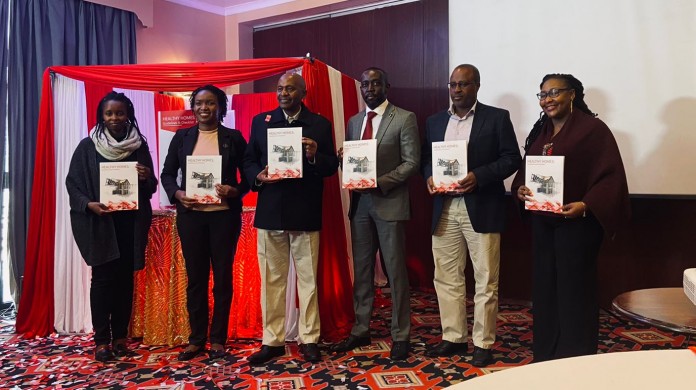The Architectural Association of Kenya (AAK) and Habitat for Humanity have launched guidelines for building a healthy home.
The guidelines which were launched in Nairobi on Friday outline 15 pillars to look into to achieve a healthy home and a matrix at the end that can be filled and tallied to check the health status of a home.
According to AAK and Habitat for Humanity, the guidelines dubbed ‘Healthy Homes Guidelines and Checklist’ are also meant to educate industry players and the general public on the relationship between housing and health, and the various elements one needs to look out for when planning to build or rent a home.
They provide design standards that will help all housing typologies, including those in informal settlements, to be resilient to COVID-19 and future pandemics.
Speaking during the launch, Principal Secretary, State Department for Public Works Solomon Kitungu noted that the pandemic had exposed the soft underbelly of Kenya’s housing situation, especially in informal settlements.
“As we navigate the third year of the pandemic and adapt to the new normal, combining the Right to the City, the Right to Housing, and the Right to Health puts us one step closer to building back better as we leave no one or no place behind. The pandemic changed the status quo, and we must adapt or perish,” said PS Kitungu.
“With more activities happening at home than the traditional definition, there is a need to redefine, redesign, and re-imagine how buildings and homes should be constructed or redesigned post the COVID-19 pandemic,” he added.
The guidelines are cognisant of the fact that most builders are self-builders who engage artisans and unqualified contractors. They provide the minimum standard which should be adhered to during construction and renovation and can guide the vetting of already constructed homes.
“It is therefore important that these guidelines are cascaded to reach these persons so they have health in mind as they construct houses in Kenya. We firmly believe that this intervention will improve the housing situation in this country and will greatly support the government’s plan to roll out massive affordable housing programs,” said David Gaitho, National Construction Authority (NCA) Chairperson.
The launch of the guidelines come at a critical time when the country has been experiencing a rampant collapse of buildings.
Also at the launch was AAK President Arch Wilson Mugambi who said AAK was willing to work with all the stakeholders in implementing the Healthy Homes Guidelines and Checklist and help solve the issue of collapsed buildings while promoting professionalism and integrity in the built and natural environment.
“We call upon the construction regulators- county governments, the National Construction Authority, the National Building Inspectorate, and the National Environment Management Authority – to work with the private sector and professionals to bring an end to this menace,” said AAK President Arch Wilson Mugambi.

The launch follows the signing of a Memorandum of Understanding (MoU) between AAK and Habitat for Humanity International in which both parties expressed their willingness to engage in an effort to promote innovations in shelter, adoption, and popularization of healthy housing best practices through joint research and information sharing targeting households, built environment professionals, artisans, and policymakers.
Pursuant to the MoU, the parties conducted a housing assessment in March 2022, with a focus on low-cost houses across the informal settlements and other rural areas within the Nairobi Metropolitan region.
The main objective of the survey was to articulate the relationship between housing and health, strengthen communication efforts toward decent and healthy housing, and inform the design and construction of affordable and healthy homes post-COVID.
A healthy home significantly contributes to the physical and mental well-being of those living in it. The majority of Kenyans living in urban areas have homes in informal settlements which are characterized by a very dense population, inadequate infrastructure, and very low-cost and low-quality houses that expose them to health risks.
Surveys conducted in rural areas found that the majority of people live in houses that are evidently lacking in suitable design elements that support healthy living such as adequate lighting, ventilation, and sanitation among others. A similar situation exists in rural areas where, despite being less densely populated, the housing conditions are deficient, considering the design and building work is carried out by untrained persons.
Vector proofing is also a major issue that affects the inhabitants of informal settlements and low-cost houses where the design elements do not protect the inhabitants from attacks by disease-causing vectors such as mosquitoes. Yet most of these vectors can be controlled through proper house designs and improvements.
According to the surveys, 80% of buildings in Kenya are built without engaging professionals. This means that most buildings in the country are built by unqualified professionals and lack the minimum standard of a healthy home. Many of these buildings suffer from sick building syndrome – a cause of numerous illnesses experienced by residents who are completely oblivious of the cause.













